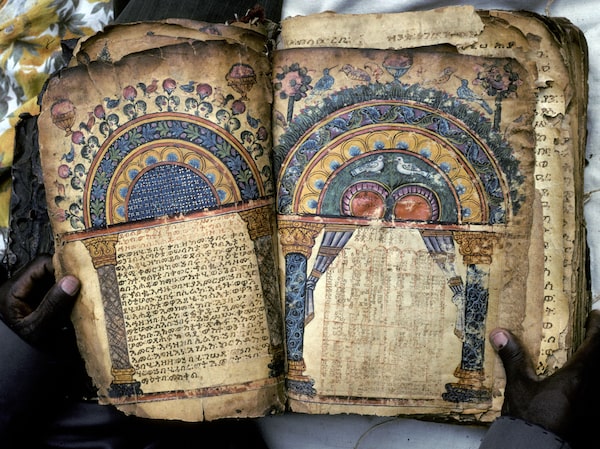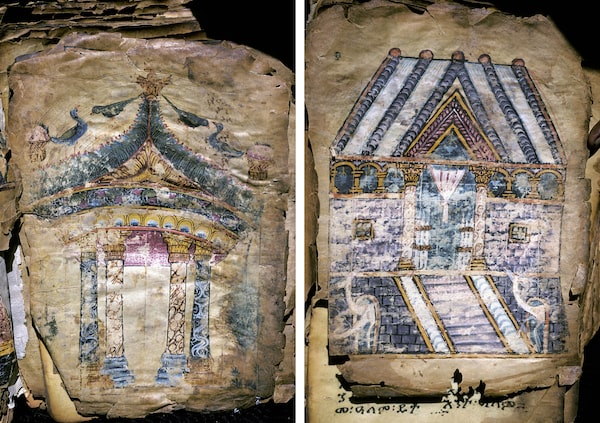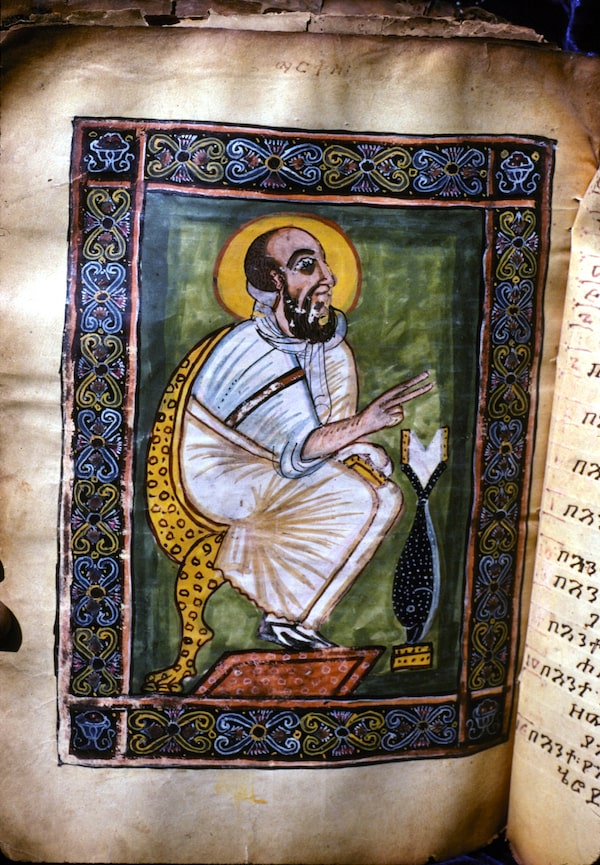
The Garima Gospels, an illuminated manuscript that dates to the fifth century, is a potentially threatened religious treasure in the Tigray region of Ethiopia, where a bloody conflict between Eritrean and Ethiopian forces has also endangered ancient churches and mosques.Photos courtesy of Michael Gervers/University of Toronto
When a Canadian scholar first glimpsed the ancient Garima Gospels, carried carefully into the sunlight by monks in a mountain monastery in northern Ethiopia, the pages were tattered and crumbling.
“The parchment was so brittle that flakes fell to the ground at every turn,” wrote Michael Gervers, a historian at the University of Toronto, recalling his earliest encounter with the manuscript more than 20 years ago.
Even then he did not fully realize what he was seeing. Some experts now believe it could be the world’s oldest intact version of illuminated Christian scripture. Radiocarbon analysis revealed that its pages date back as early as the fifth century, making it one of the oldest manuscripts of any kind in the world. Its brilliant colours and stunning illustrations make it even more valuable to world culture.
Today, after surviving 1,500 years of human history in a remote monastery, the Garima Gospels are facing their most severe threat.
War has ripped through the Tigray region of northern Ethiopia for the past six months. Shelling, gunfire and looting have ravaged churches and monasteries across the region.
Historic manuscripts, along with church icons and silver crosses, are among the treasures that have been plundered by Eritrean and Ethiopian soldiers, raising global alarm for Tigray’s cultural heritage.
Cut off from the world by military clashes and telecommunications shutdowns, the fate of the Abba Garima monastery and its spectacular Garima Gospels is still unknown. But the area around the monastery is controlled by soldiers who have looted systematically since the start of the war. The fears are growing.
“It is chilling to many of us to think that these Gospels and other ancient artifacts are in the way of danger,” said Suleyman Dost, a professor in the Near Eastern and Judaic Studies department at Brandeis University in Massachusetts.
“These Gospels are not only among the earliest complete texts of the Christian scripture, but they also provide us with a rare glimpse into the language, religion and history of ancient Ethiopia,” he told The Globe and Mail in an e-mail.
“They are truly part of the world heritage and constitute indispensable sources for scholars of early Christianity, late antique Ethiopia and even early Islam.”


The lavishly illustrated gospels are written in Ge'ez, a language of the ancient kingdom of Axum. Ge'ez survives only as a liturgical language in Ethiopian Orthodox Christianity and Judaism, but is closely related to Tigrinya, which is widely spoken in modern Tigray region.

A monk holds Garima Gospels, which have never been stored in a museum, only in monasteries.
The Garima Gospels, bound and illustrated copies of the Four Gospels of the New Testament written in the classical Ethiopian language Ge’ez, are one of the treasures of the ancient Axumite kingdom, whose heartland is now engulfed by the war zone in Tigray.
“The war threatens countless invaluable remains from this period, including inscriptions, religious buildings and manuscripts that have been diligently preserved in monasteries for centuries,” Prof. Dost said.
The Axumite kingdom, whose territories extended across the Red Sea into modern-day Yemen, was one of the great cultural and economic empires of its time, a crossroads of early civilizations and one of the first states to accept Christianity as state religion, in the early fourth century, before even the Roman Empire. Its capital, Axum, is reputed by tradition to be the home of the Ark of the Covenant – another holy relic whose fate is unknown today.
“It was the one territory which retained its Christianity without external domination and has done so ever since,” Prof. Gervers said.
“It is the oldest free Christian culture in the world. And that culture was centred in what is now Eritrea and Tigray. The world is only at this point coming to recognize the importance of this area.”
The Garima Gospels are older than more famous Western manuscripts such as the Book of Kells, and a closer link to the original Greek gospels. “They are just amazing in their artistic expertise, incomparable even to early Gospel books that we have,” Prof. Gervers told The Globe in an interview. “They are of utmost importance to Christian culture as a whole. Their loss or displacement would be disastrous to the cultural heritage of Judeo-Christianity.”

'The Evangelist Mark, a page from the Garima Gospels.
Prof. Gervers has been documenting Ethiopian art and culture for decades, photographing historic church manuscripts and creating a unique database of about 70,000 digitized images, including the Garima Gospels. With no sign of the Tigray war ending soon, his database is becoming increasingly crucial. “We’re thankful that we were able to document so much of this over the past 30 years,” he said.
Among the most invaluable illustrations in the Garima Gospels, he said, are an unparalleled image of the evangelist Mark, and a rare image of a building that has been identified as the Old Temple in Jerusalem.
The war in Tigray has inflicted more destruction on Ethiopia’s religious and cultural heritage than anything since the invasions of Ahmad ibn Ibrahim al-Ghazi, who burned churches and manuscripts across the country in the 16th century, Prof. Gervers said.
He and his colleagues are trying to monitor the antiquities markets, in case any looters try to sell the manuscripts. “It would be an offence to Christianity if the Garima Gospels ended up for sale somewhere.” Even worse, soldiers could simply burn the manuscripts “out of spite,” he said. But so far their fate is a mystery. “We haven’t heard a word about it.”
Wolbert Smidt, an ethnohistorian at Jena University in Germany who studies Ethiopian culture and history, said he has received reports of soldiers regularly searching churches and sometimes looting or burning church relics, including rare parchment manuscripts that were written by hand in late antiquity.
But there is still hope, he says. During conflicts of past centuries, the monks of Abba Garima carefully hid the Garima Gospels, possibly in mountain caves. Today there is a chance that the monks may have succeeded in hiding them again.
The danger zones for Ethiopia’s cultural heritage

Churches, monasteries and mosques have been damaged by shelling from Ethiopian forces, while historic manuscripts have been looted by Eritrean troops. The fate of the Garima Gospels, at Abba Garima, is still unknown.
Legend
YEMEN
Church
Monastery
ETHIOPIA
Mosque
Addis Ababa
City
0
500
KM
0
1,000
ERITREA
KM
Abba
Garima
EASTERN
TIGRAY
Debre
Damo
Axum
al-Nejashi
Abuna
Aregawi
CENTRAL
St. George
Mekelle
AFAR
SOUTH
EASTERN
AMHARA
SOUTHERN
THE GLOBE AND MAIL, SOURCE: UNITED NATIONS OFFICE FOR THE CO-ORDINATION OF HUMANITARIAN AFFAIRS

Churches, monasteries and mosques have been damaged by shelling from Ethiopian forces, while historic manuscripts have been looted by Eritrean troops. The fate of the Garima Gospels, at Abba Garima, is still unknown.
Legend
YEMEN
Church
Monastery
ETHIOPIA
Mosque
Addis Ababa
City
0
500
KM
0
1,000
ERITREA
KM
NORTH
WESTERN
Abba
Garima
EASTERN
TIGRAY
Debre
Damo
Abuna
Aregawi
Axum
al-Nejashi
CENTRAL
St. George
Mekelle
AFAR
SOUTH
EASTERN
AMHARA
SOUTHERN
THE GLOBE AND MAIL, SOURCE: UNITED NATIONS OFFICE FOR THE CO-ORDINATION OF HUMANITARIAN AFFAIRS

Churches, monasteries and mosques have been damaged by shelling from Ethiopian forces, while historic manuscripts have been looted by Eritrean troops. The fate of the Garima Gospels, at Abba Garima, is still unknown.
0
1,000
ERITREA
KM
NORTH
WESTERN
Abba
Garima
EASTERN
Debre
Damo
TIGRAY
Abuna
Aregawi
Axum
al-Nejashi
WESTERN
CENTRAL
St. George
Mekelle
AFAR
SOUTH
EASTERN
Legend
YEMEN
Church
AMHARA
Monastery
ETHIOPIA
SOUTHERN
Mosque
Addis Ababa
City
0
500
KM
THE GLOBE AND MAIL, SOURCE: UNITED NATIONS OFFICE FOR THE CO-ORDINATION
OF HUMANITARIAN AFFAIRS
Our Morning Update and Evening Update newsletters are written by Globe editors, giving you a concise summary of the day’s most important headlines. Sign up today.